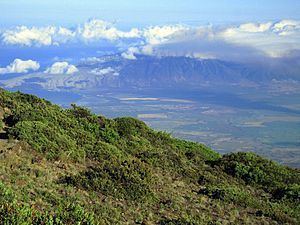Global 200 No | Conservation status Vulnerable Area 1,900 km² | |
 | ||
The Hawaiian tropical high shrublands are a tropical savanna ecoregion in the Hawaiian Islands. They cover an area of 1,900 km2 (730 sq mi) on the upper slopes of the volcanoes Mauna Kea, Mauna Loa, Hualālai, and Haleakalā. They include open shrublands, grasslands, and deserts. Shrubland species include ʻāheahea (Chenopodium oahuense), ʻōhelo ʻai (Vaccinium reticulatum), naʻenaʻe (Dubautia menziesii), and ʻiliahi (Santalum haleakalae). Alpine grasslands are dominated by tussock grasses, such as Deschampsia nubigena, Eragrostis atropioides, Panicum tenuifolium, and pili uka (Trisetum glomeratum). Deserts occur on the coldest and driest peaks, where only extremely hardy plants such as ʻāhinahina (Argyroxiphium sandwicense) and Dubautia species are able to grow. The nēnē (Branta sandvicensis) is one of the few birds found in alpine shrublands, while ʻuaʻu (Pterodroma sandwichensis) nest in this ecoregion.
